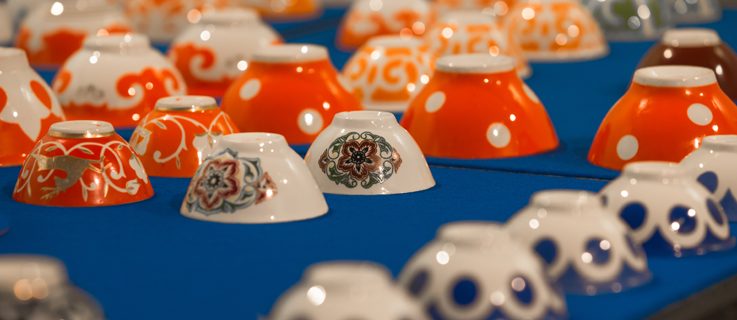100 Pialas, installation, 2015
The starting point was the idea to undertake a specific cultural study based on one cultural item. For an artist born in Kazakhstan, a piala (a bowl) became such an artefact. At one time in the Soviet era, pialas actively ‘travelled around’: for a Soviet citizen, a trip to Central Asia was one of the few opportunities to see a different way of life, to become acquainted with a different culture; people willingly brought the artefacts of little known cultures back home. The idea of relocation of the object from its "natural environment" into the context where it becomes rare, exotic, something attractive and at the same time foreign was actively pursued – however, pialas, with their regional peculiarities, began to be produced all over the Soviet Union, giving the opportunity to bring something exotic into every Soviet home. Nowadays, pialas are regarded more as one of the many symbols of a bygone era, fragments recalling the Soviet past: the idea of friendship between peoples sank into oblivion, the factories where many of these bowls were produced are now closed and derelict.
For Katya Isaeva, collecting pialas became synonymous with the collecting of human stories: some people came by pialas quite by chance, others kept them as family heirlooms. Each one of the presented pialas passed on to the artist has its own life story, but together they constitute an historical allegory on a much-repeated story of cross-cultural interaction.
Katya Isaeva
* 1980 in Karaganda, lives and works in Moscow, Russia
Since 1997 has been living and working in Moscow. MA degree in linguistics, studied Graphic design and Art at the University of the Arts, London, participant of Laboratory of Media Poetry, alumni of ICA, Moscow. Participant of parallel and special programs of Manifesta 2014, Young Art Biennial 2014, 6th Moscow Biennial, 2015, International Tarkovsky Film Festival “ZERKALO”, Danube video art festival, Austria, exhibitions in MMOMA. Works with video installations, site-specific installations, media poetry.
Using some experience in translation and intercultural communication the artist works not with the cultural codes only, but with all basic sensitive and psychological aspects of reality – visual, audile, tactile and memory. In her work she tries to transfer texts/stories to the visual surface, establish ties between the word and the object and determine connections between objects and the person who makes use of them.
